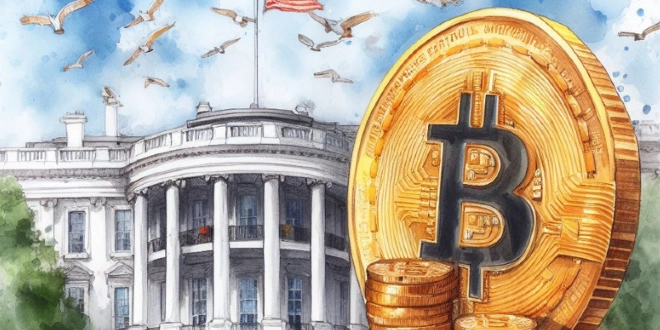The U.S. Department of Justice (DOJ) announced on October 14, 2025, that it had forfeited 127,271 bitcoins linked to a Cambodia-based criminal operation. Shortly after the news broke, social media erupted with speculation that the U.S. government now controls as much as 325,000 to 327,000 BTC — figures shared widely by crypto influencers and industry insiders. But are these claims accurate, and what does the government truly “hold”?
The Origin of the 327,000 BTC Claim
Following the DOJ’s announcement, several high-profile crypto commentators — including JP Richardson, CEO of Exodus wallet — claimed that the U.S. now possesses around 327,000 BTC. Others cited a slightly smaller figure of 325,000 BTC, attributing the data to on-chain analytics.
However, there’s a crucial distinction between what the U.S. government owns and what it merely holds in temporary custody. Many of the reports referenced “seized” bitcoins, allegedly taken from Chinese businessman Chen Zhi and the criminal network known as Price Group. Yet, the DOJ’s press release did not use the word seized — it used forfeited.
That distinction is legally significant. As the FBI’s asset forfeiture guidelines explain:
“Forfeiture removes the profit motive from the crime and returns property obtained under fraudulent pretenses by the criminal to the victims.”
In other words, forfeited assets are not automatically property of the U.S. government — they are held pending potential restitution to victims.
DOJ’s Crackdown and Statement on the Case
In announcing the forfeiture, Attorney General Pamela Bondi and Deputy Attorney General Todd Blanche described it as one of the largest actions ever taken against a transnational criminal network.
“Today’s action represents one of the most significant strikes ever against the global scourge of human trafficking and cyber-enabled financial fraud,” their joint statement read. “By dismantling a criminal empire built on forced labor and deception, we are sending a clear message that the United States will use every tool at its disposal to defend victims, recover stolen assets, and bring to justice those who exploit the vulnerable for profit.”
Their comments suggest that at least a portion of the forfeited bitcoins could eventually be returned to victims, rather than retained as part of the U.S. government’s permanent holdings. This would not be unprecedented — in 2024, the DOJ recommended returning 94,643 BTC recovered from the Bitfinex hack to the exchange itself.
However, those funds have still not been transferred back, leaving uncertainty over how quickly such restitution might occur.
Trump’s Strategic Bitcoin Reserve Adds Complexity
The situation is further complicated by the creation of the Strategic Bitcoin Reserve (SBR) under an executive order signed by President Donald Trump on March 6, 2025. The order prohibits the sale of any bitcoin currently held by the U.S. government, describing these holdings as “strategic national assets.”
According to the fact sheet accompanying the order:
“Taking affirmative steps to centralize ownership, control, and management of these assets within the federal government will ensure proper oversight, accurate tracking, and a cohesive approach to managing the government’s cryptocurrency holdings.”
While the order ensures tighter control over digital assets, it introduces uncertainty about how forfeited bitcoins — particularly those earmarked for restitution — can be legally returned to victims if they are considered part of a “strategic reserve.”
Estimating the U.S. Government’s Bitcoin Holdings
Because the U.S. government does not publish official audits of its crypto holdings, analysts rely on on-chain data from firms like Arkham Intelligence. As of October 16, 2025, Arkham’s data estimates that the U.S. controls roughly 325,447 BTC.
This figure aligns more closely with blockchain evidence than the viral 327,000 BTC claim. The higher estimate likely emerged from a simple addition — combining the newly forfeited 127,000 BTC with the previously reported 200,000 BTC attributed to the U.S. following the launch of the SBR.
However, this approach ignores the fact that some of these bitcoins — such as those tied to the Bitfinex case — may eventually be returned, and therefore cannot be considered permanent government assets.
Where the Bitcoin Is Held
Of the estimated 325,000 BTC currently associated with U.S. government wallets:
- 94,000 BTC may still be designated for potential return to Bitfinex;
- Around 29,000 BTC remain in the custody of the U.S. Marshals Service, which manages government-controlled digital assets and has historically auctioned off seized coins;
- The remaining balance consists of forfeited assets under ongoing review by the DOJ and related agencies.
Despite Trump’s directive prohibiting bitcoin sales, it remains unclear whether the Department of Justice, the Treasury, or the White House has final authority over how these digital assets are managed — particularly when victim compensation or international restitution is involved.
The Bottom Line
While social media figures have claimed that the U.S. now holds 327,000 BTC, on-chain data suggests the figure is closer to 325,000. Moreover, much of this bitcoin may eventually be returned to rightful owners or remain frozen under legal review, rather than being permanently absorbed into federal reserves.
Until the U.S. government conducts a public audit — as required under Trump’s executive order — the precise scope of its cryptocurrency holdings will remain a matter of informed estimation rather than confirmed fact.
 The Daily Star Ireland
The Daily Star Ireland

